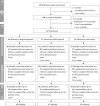Effectiveness of a parent-focused intervention targeting 24-hour movement behaviours in preschool-aged children: a randomised controlled trial
- PMID: 39252110
- PMCID: PMC11385828
- DOI: 10.1186/s12966-024-01650-2
Effectiveness of a parent-focused intervention targeting 24-hour movement behaviours in preschool-aged children: a randomised controlled trial
Abstract
Background: Interventions focusing on individual behaviours (physical activity, sedentary behaviour, sleep) of preschool-aged children have been widely studied. However, there is a lack of understanding about integrated interventions that target all three 24-hour movement behaviours. This is the first study to assess the effectiveness of an intervention aimed at improving all three 24-hour movement behaviours among preschoolers in Hong Kong.
Methods: A 12-week randomised controlled trial with a 12-week follow-up was conducted. Parent-child pairs were randomised to integrated approach (targeting all three behaviours), dyadic approach (targeting physical activity and sedentary behaviour including screen time), or wait-list control group. Utilising the Internet-based delivery, this intervention consisted of education materials, workshops, and interactive questionnaires and reminders. Two intervention groups employed the same strategies, with the only difference being that the integrated approach targeted sleep in addition to physical activity and sedentary behaviour. The outcomes were preschoolers' overall 24-hour movement behaviours which were assessed by the Activity Sleep Index (ASI), movement behaviour composition, and absolute duration of movement behaviours. Generalised estimating equations were conducted to evaluate the intervention.
Results: A total of 147 preschoolers (4.8 ± 0.9 years old, 56.5% boys) and their parents were included. Preschoolers in all groups had a lower ASI at follow-up compared with baseline. Preschoolers in the integrated approach had a smaller decline in ASI at follow-up, compared to that in the control group (3.41; 95% confidence interval [CI] = 0.07, 6.76). Preschoolers in both intervention groups had a smaller reduction of the composition of time spent in physical activity at follow-up, and a decreased screen time at postintervention and follow-up. No significant differences were found for the sleep subcomponent. Furthermore, preschoolers in the dyadic approach had a smaller increase in the sedentary behaviour subcomponent (vs.
Control: - 0.21; 95% CI = - 0.37, - 0.05) at follow-up.
Conclusions: Both intervention groups showed a decrease in screen time at postintervention, but there were no significant changes in other behaviours. The favourable changes observed at follow-up demonstrated the effectiveness of both intervention approaches on alleviating the decline in the composition of time spent in physical activity and reducing screen time and revealed the possible effectiveness of the integrated approach in promoting overall movement behaviours among preschoolers.
Trial registration: The study is prospectively registered at the Chinese Clinical Trial Registry (ChiCTR2200055958).
Keywords: Physical activity; Preschooler; Sedentary behaviour; Sleep.
© 2024. The Author(s).
Conflict of interest statement
The authors declare that they have no competing interests.
Similar articles
-
Effects of movement behaviors on preschoolers' cognition: a systematic review of randomized controlled trials.Int J Behav Nutr Phys Act. 2025 Jan 23;22(1):12. doi: 10.1186/s12966-025-01705-y. Int J Behav Nutr Phys Act. 2025. PMID: 39849503 Free PMC article.
-
Effectiveness of a Parent-Focused Intervention Targeting 24-H Movement Behaviors in Preschool-Aged Children: Study Protocol for a Randomized Controlled Trial.Front Public Health. 2022 May 23;10:870281. doi: 10.3389/fpubh.2022.870281. eCollection 2022. Front Public Health. 2022. PMID: 35677761 Free PMC article.
-
The association between 24-h movement behaviours and adiposity among Australian preschoolers: a compositional data analysis.BMC Public Health. 2025 Jan 29;25(1):368. doi: 10.1186/s12889-024-21217-x. BMC Public Health. 2025. PMID: 39881264 Free PMC article.
-
Effectiveness of a Parent-Based eHealth Intervention for Physical Activity, Dietary Behavior, and Sleep Among Preschoolers: Protocol for a Randomized Controlled Trial.JMIR Res Protoc. 2024 Sep 12;13:e58344. doi: 10.2196/58344. JMIR Res Protoc. 2024. PMID: 39264108 Free PMC article.
-
Tools to guide clinical discussions on physical activity, sedentary behaviour, and/or sleep for health promotion between primary care providers and adults accessing care: a scoping review.BMC Prim Care. 2023 Jul 7;24(1):140. doi: 10.1186/s12875-023-02091-9. BMC Prim Care. 2023. PMID: 37420229 Free PMC article.
Cited by
-
Effect of intervention on screen time in preschoolers: a systematic review and meta-analysis of randomized controlled trials.BMC Public Health. 2025 Aug 11;25(1):2724. doi: 10.1186/s12889-025-23700-5. BMC Public Health. 2025. PMID: 40790184 Free PMC article.
-
Effects of movement behaviors on preschoolers' cognition: a systematic review of randomized controlled trials.Int J Behav Nutr Phys Act. 2025 Jan 23;22(1):12. doi: 10.1186/s12966-025-01705-y. Int J Behav Nutr Phys Act. 2025. PMID: 39849503 Free PMC article.
References
-
- World Health Organization. Guidelines on physical activity, sedentary behaviour and sleep for children under 5 years of age. Geneva PP - Geneva: World Health Organization. 2019. https://extranet.who.int/iris/restricted/handle/10665/311664 - PubMed
Publication types
MeSH terms
LinkOut - more resources
Full Text Sources
Medical


